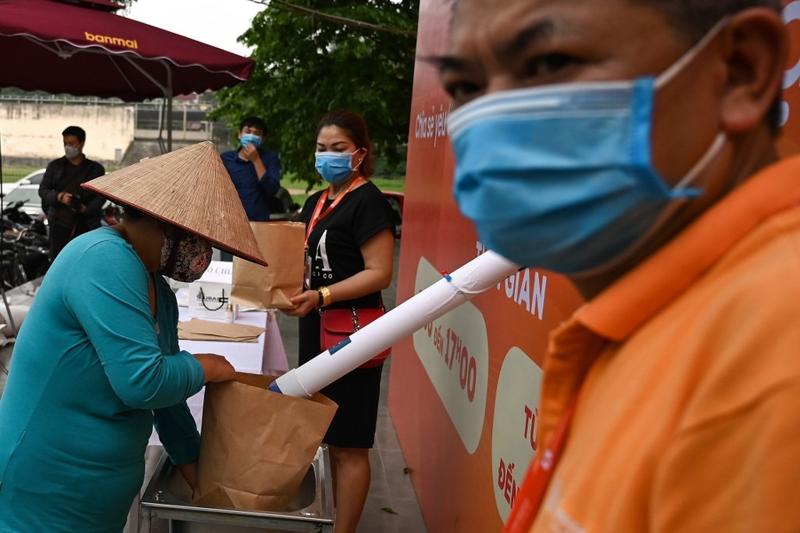 A resident wearing a face mask fills a paper bag with free rice in Hanoi on April 11,2020. Vietnamese have been restricting their movements as a preventive measure against the spread of the novel coronavirus. (MANAN VATSYAYANA / AFP)
A resident wearing a face mask fills a paper bag with free rice in Hanoi on April 11,2020. Vietnamese have been restricting their movements as a preventive measure against the spread of the novel coronavirus. (MANAN VATSYAYANA / AFP)
Vietnam and China can achieve victory together against COVID-19 as they understand and support each other, according to analysts.
The battle against the pandemic will further enhance understanding and friendship of both nations
Do Thanh Van, president of the Vietnamese party of the Confucius Institute of Hanoi University
“The battle against the pandemic will further enhance understanding and friendship of both nations,” Do Thanh Van, president of the Vietnamese party of the Confucius Institute of Hanoi University, told China Daily.
From Jan 25 to April 12, Vietnam had 258 confirmed cases of COVID-19 with no death, according to the World Health Organization. More than 125 patients have recovered.
China has adopted desirable comprehensive approaches in its intense battle against the pandemic over the past months and exercised caution in resumption of production, said Dog Guagn Vinh, a young conductor from Hanoi. “What China has done to control the pandemic can be an example for the rest,” he said.
He also noted that people like him have been largely following government instructions and staying home most of the time. “Following guides by the government provides me a sense of security,” he said.
People in the two countries have been supporting each other, Do said. When China was at the peak of suffering, the institute donated masks to Guangxi Teachers’ University and the Chinese embassy in Hanoi. Later, Hanoi University has been receiving donations from the Chinese side, including traditional Chinese medicine which have been used in Wuhan and proven effective during treatment of local patients.
Vietnam itself is gearing up preparations for a new wave of COVID-19 infections after gaining initial progress in containing its spread with comprehensive approaches.
“Vietnam has taken quite good and comprehensive approach (when dealing with the COVID-19), because they have started early contact tracing, quarantine measures and a progressive policy of social distancing,” said Thirumalaisamy P Velavan, founder and director of the Vietnamese-German Center for Medical Research in Hanoi.
“They have responded to do this quite early. During the early phase of the COVID-19, they have stopped flights, restricted access (to the country) and made individuals to stay back home,” said Velavan, who is also a professor and group leader at the Institute of Tropical Medicine of the Universitatsklinikum Tubingen in Germany.
Guy Thwaites, director of the Oxford University Clinical Research Unit (OUCRU) in Vietnam, said the country was very rigorous with its case control management, particularly for flights and incoming passengers. “Their measures to identify those who were infected or even just exposed at the airports and quarantine (measures) were very robust,” he said.
Referring to the zero fatality in Vietnam, Guy Thwaites, director of the Oxford University Clinical Research Unit in Vietnam, one of the major reasons is that a large proportion of infectors have been young so they tend to be less vulnerable to COVID-19 than the elderly or those with other disease such as diabetes and hypertension.
Still, “Vietnam has had a number of people with critical illness, who required ventilation, even ECMO, but all of them so far have survived,” said Thwaites. The country was very rigorous with its case control management, particularly for flights and incoming passengers. “Their measures to identify those who were infected or even just exposed at the airports and quarantine (measures) were very robust,” he said.
Vietnam declared COVID-19 a nationwide epidemic on April 1, according to Xinhua.
Noting that the Vietnamese government has played a vital role in identifying and secluding infection clusters, Velavan said the country, which is doing 1,100 tests per 1 million population, has responded to the COVID-19 situation and handling well in terms of test, treat and track approach.
He said his institute has started clinical trial to treat COVID-19 patients “in a placebo-controlled way”, possibly the first in the countries.
Despite slow spread, Vietnamese Prime Minister Phuc on April 6 requested preparing scenarios for the second wave of infections.
ALSO READ: ASEAN holds special summit on response to COVID-19 pandemic
A new wave of infections may only be possible when things are back to normal and borders are open, because this might lead to a high inflow of tourists, said Velavan. “There might be one or two sporadic cases later, but I don't expect that the numbers will shoot up much higher in the next couple of weeks,” he added.
Moreover, “Vietnam has not got large numbers of patients at the moment and that’s buying time to put these measures in place,” said Thwaites.
People in Vietnam are beating the odds for daily life while following social distancing guidelines. Conductor Dog said he has to sacrifice performances at home and abroad during the period but was enjoying time with his families and caring for his child while practising with other musicians online.
“Quite a few online performances and exchanges are rather appreciated,” he said. Dog has kept musical exchanges with students and orchestras from home and abroad online, including some from Shanghai. “I’m kept busy even though working from home,” he said.
READ MORE: China's response to COVID-19 offer SE Asia lessons to share
Thwaites said his research unit has started clinical trials with COVID-19 patients to chloroquine treatment, in addition to setting up a lab in Ho Chi Minh city with the Vietnamese government that can test up to 1,000 specimens per day.
They are also helping with the country to prepare various scenarios that might play out over the next few months, especially in terms of the demand for intensive care resources.
Contact the writer at wangjian@chinadaily.com.cn.


